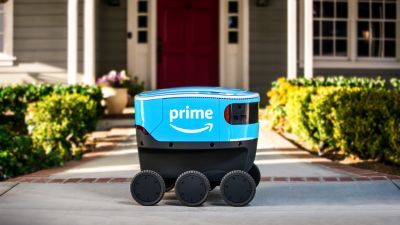
- Amazon announced in its first-quarter earnings this week that it will spend $800 million to make one-day shipping the new standard for Prime members across the country.
- An even bigger logistics innovation in delivery is being tested in Snohomish, Washington, where six Amazon Scout robots have been delivering packages to customers since January.
- A United States Postal Service survey found that a majority of Americans embrace the idea of robot delivery, but the USPS also concludes that late-mile delivery by independent robots is not ready for wide-scale use.
The people who deliver our packages to us may soon have some competition.
In January, the e-commerce giant Amazon announced that it had begun field-testing Amazon Scout, a robot that’s been delivering packages to customers in Snohomish County, Washington. The United States Postal Service is also exploring ways to use delivery robots.
According to a post on the Amazon AMZN blog Day One, there are just six Scout robots in existence , and they only deliver during daylight hours on weekdays. An Amazon spokesperson who spoke with CNBC could not comment on the program beyond what’s on the blog, so for now the future of the rollout remains murky.
Whatever plans Amazon has for Scout, it’s only natural to wonder what effect widespread adoption would have on the delivery jobs that are currently being performed by human beings. Do these workers need to brace themselves for the possibility that they may soon be obsolete?
According to a 2018 report issued by the United States Postal Service’s Office of the Inspector General, more Americans embrace the idea of robotic delivery than oppose it. Those who support it said robot delivery could offer greater flexibility to package recipients and reduce the risk of injury to delivery personnel. As far as the drawbacks, respondents cited job losses as a primary concern. However, postal delivery workers won’t have to worry about being put out of jobs just yet.
According to ” Autonomous Mobile Robots and the Postal Service ,” a 2018 report issued by the United States Postal Service’s Office of the Inspector General, the use of autonomous mobile robots for last-mile delivery of mail “is too economically and technologically immature to be scalable in the short term, especially for independent robot delivery applications.”
And Diana Dawson, vice president of consulting for the research firm Envirosell, said that job losses aren’t the only problem to consider.
“[The Scout] probably cannot negotiate the many variables that are involved in home delivery, such as steps, rain and customers who are not there when the robot opens its lid,” she said. “This would likely lead to a delay in delivery, which is a pain point for Amazon shoppers in particular.”
Monica Eaton-Cardone is the owner and chief operating officer of the financial technology company Chargebacks911, which manages 200 million online transactions per month and has spent a lot of time studying delivery systems since the category can be rife for fraud. She said robot delivery faces several major hurdles.
“A few years ago, a robot named HitchBOT was hitchhiking throughout different cities in an experiment to test human psychology,” she said. “HitchBOT was beheaded in Philadelphia… will we treat an Amazon robot any better?”
Robotic delivery systems would also make it easier for consumers to say they never got a package and commit chargeback fraud than if the UPS UPS guy made them sign for something.
As far as benefits, Eaton-Cardone cited cost reductions on Amazon’s part as well as a possible increase in delivery speed. She also said it might unexpectedly benefit infrastructure.
“Companies like Amazon wield immense power, both economically and politically,” she said. “Our politicians might not prioritize the rebuilding of our sidewalks and streets when only humans were using them, but I have a feeling it’ll become much more of a priority when Amazon’s robots need to use them too.”
Amazon has explored the possibility of robotic delivery before.
The first vehicle the company intended to use was the Prime Air drone, which made its first delivery in December 2016 . That program has since gone quiet, but it still has some advantages over Scout, namely speed. After all, impulse buyers might balk at a purchase that takes three days to reach them, but they might buy it if delivery only takes half an hour.
“A fast drone can fly at 50 miles per hour, over 10 times faster than Scout,” said Nicholas Farhi, partner at the global consulting firm OC&C Strategy. “It will become quicker to have something delivered than to make a trip to the local store, unlocking a big new chunk of ‘need it now,’ low premeditation retail sales to delivery.”
Jeff Harris, a partner at Harris Lowry Manton who specializes in product liability, catastrophic injury and wrongful death, said that those benefits aside, drone deliveries present drawbacks that may outweigh the advantages, all of them attributable to the lack of human decision-making.
“The biggest problem with delivery drones is going to be how to create separation between drones, so they don’t crash into each other, potentially injuring people and causing property damage,” he said.
Amazon Scout could encounter difficulties when negotiating sidewalks.
“When we walk down the street, we’re constantly making a series of complex decisions,” Harris said. “Programs like Amazon Scout will likely face the same challenges that automated vehicles are currently experiencing because they encounter random, real-life situations that aren’t pre-programmed and part of the algorithm.”
While the physical risks of robotic delivery may be debatable, Harris said that it will almost certainly cost delivery workers their jobs. Monica Eaton-Cardone of Chargebacks911 agreed.
“Automation, drones and robots are all coming to home delivery,” she said. “Industry-wide upheaval is inevitable and a lot of good, hard-working men and women will lose their jobs.”
Still, Eaton-Cardone said not to write off the human element just yet. There are things only human beings can do and which no amount of technology can replace.
“If a company is delivering a high-end product or an item with potential legal or health liabilities, then it might still make economic sense to have a human being oversee the delivery, answer questions, sign forms, and then try to secure future sales,” she said. Eaton-Cardone also said that human beings provide more than just the ability to navigate complicated delivery instructions.
“Sometimes, the kind words or a reassuring smile of an actual, real-life person makes all the difference in the world,” she said.
More From CNBC











